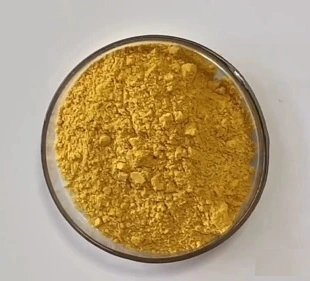Diacerein Powder vs. Glucosamine: Which is Better?
When it comes to managing osteoarthritis (OA), two popular supplements often come up in discussions: diacerein powder and glucosamine. Both have garnered attention for their potential benefits in alleviating joint pain and improving overall joint health. However, understanding the differences between these two supplements and their effectiveness is crucial for making an informed decision about which one might be better suited for your needs.
In this comprehensive guide, we'll delve into the key differences between diacerein and glucosamine, examine their effectiveness for osteoarthritis, and explore whether they can be used together. By the end of this article, you'll have a clearer understanding of these supplements and be better equipped to make decisions about your joint health.

Key Differences Between Diacerein and Glucosamine
Diacerein and glucosamine are two distinct compounds with different origins, mechanisms of action, and potential benefits. Let's break down the key differences between these two supplements:
Origin and Composition
Diacerein Powder is a synthetic compound derived from anthraquinone. It's classified as a slow-acting medicine and is primarily used to treat joint diseases such as osteoarthritis. On the other hand, glucosamine is a naturally occurring compound found in the body, particularly in cartilage. Commercial glucosamine supplements are typically derived from shellfish or produced synthetically.
Mechanism of Action
Diacerein works by inhibiting interleukin-1 beta, an inflammatory cytokine involved in the progression of osteoarthritis. This inhibition may help reduce inflammation and slow down cartilage degradation. Glucosamine, conversely, is believed to support cartilage health by providing building blocks for cartilage synthesis and potentially reducing inflammation.
Regulatory Status
Diacerein is registered as a medication in some European Union and Asian countries. However, it's not approved by the FDA in the United States. Glucosamine, while widely available as a dietary supplement in the US, is not FDA-approved for any specific medical indication.
Side Effects
Diacerein is associated with some notable side effects, particularly gastrointestinal issues. The most common side effect is diarrhea, which can be severe in some cases. Other potential side effects include abdominal pain, nausea, and flatulence. Glucosamine is generally well-tolerated, with mild side effects such as nausea, heartburn, and diarrhea reported in some individuals.
Dosage and Administration
Diacerein is typically administered at a dose of 100 mg daily, often split into two 50 mg doses. However, due to the risk of severe diarrhea, it's recommended to start with a lower dose of 50 mg daily, especially in patients aged 65 and above. Glucosamine dosages vary, but a common recommendation is 1500 mg daily, often taken in divided doses.
Which Supplement is More Effective for Osteoarthritis?
Determining which supplement is more effective for osteoarthritis is not straightforward, as research results have been mixed. Let's examine the evidence for each supplement:
Diacerein Effectiveness
Several studies have investigated the efficacy of diacerein in treating osteoarthritis. A 2014 Cochrane review found that diacerein had a small beneficial effect on pain associated with OA. Some research suggests that diacerein may have both symptomatic and structure-modifying effects, potentially slowing the progression of OA.
However, the European Medicines Agency (EMA) has restricted the use of diacerein powder due to safety concerns, particularly the risk of severe diarrhea. This has led to recommendations against its use in patients aged 65 and above.
Glucosamine Effectiveness
Glucosamine has been extensively studied for its potential benefits in osteoarthritis. While some studies have shown positive effects on pain reduction and improved joint function, others have found no significant benefits over placebo. The conflicting results have led to ongoing debates about glucosamine's effectiveness.
The American Academy of Orthopaedic Surgeons (AAOS) recommends against the use of glucosamine for knee osteoarthritis, citing a lack of strong evidence supporting its efficacy. However, some patients report subjective improvements in their symptoms when taking glucosamine supplements.
Comparative Effectiveness
Direct comparisons between diacerein and glucosamine are limited. Some systematic reviews and network meta-analyses have suggested that diacerein may be more effective than glucosamine in reducing pain, while both have similar efficacy in improving joint function. However, these findings should be interpreted cautiously due to the heterogeneity of available studies.
Can Diacerein and Glucosamine Be Used Together?
The possibility of combining diacerein and glucosamine has garnered interest among researchers and clinicians. The rationale behind this combination lies in the potential synergistic effects of these two supplements:
Potential Synergistic Effects
Diacerein and glucosamine have different mechanisms of action. While diacerein powder primarily works by inhibiting inflammatory processes, glucosamine is thought to support cartilage health and synthesis. Theoretically, combining these supplements could provide both anti-inflammatory and cartilage-supporting benefits, potentially leading to better outcomes than either supplement alone.
Research on Combination Therapy
While the idea of combining diacerein and glucosamine is promising, research on this specific combination is limited. Some studies have explored the potential of combination therapy, but large-scale, high-quality randomized controlled trials directly comparing the combination to monotherapy are lacking.
Safety Considerations
When considering combination therapy, it's crucial to be aware of the potential for increased side effects. Both diacerein and glucosamine can cause gastrointestinal side effects, and combining them might exacerbate these issues in some individuals. Additionally, the long-term safety of this combination has not been extensively studied.
Consultation with Healthcare Providers
If you're considering using diacerein and glucosamine together, it's essential to consult with a healthcare provider. They can evaluate your individual situation, considering factors such as your overall health, the severity of your osteoarthritis, and potential drug interactions. Your healthcare provider can help you weigh the potential benefits against the risks and make an informed decision about whether combination therapy is appropriate for you.
Conclusion
Both diacerein powder and glucosamine have shown potential benefits in managing osteoarthritis, but each comes with its own set of advantages and limitations. Diacerein may offer more potent anti-inflammatory effects but carries a higher risk of side effects, particularly gastrointestinal issues. Glucosamine, while generally well-tolerated, has mixed evidence regarding its effectiveness.
The choice between diacerein and glucosamine – or whether to use them in combination – should be made on an individual basis, taking into account factors such as the severity of osteoarthritis, overall health status, and personal tolerance to potential side effects. It's crucial to consult with a healthcare provider before starting any new supplement regimen.
For more information about diacerein powder and other plant extracts, please contact us at emily@jiubaiyuanbiotech.com. Our team at Xi'an Jiubaiyuan Biotechnology Co., Ltd. is dedicated to providing high-quality botanical extracts and supporting your health and wellness journey.

References
1. Bartels EM, Bliddal H, Schøndorff PK, Altman RD, Zhang W, Christensen R. Symptomatic efficacy and safety of diacerein in the treatment of osteoarthritis: a meta-analysis of randomized placebo-controlled trials. Osteoarthritis Cartilage. 2010;18(3):289-296.
2. Reginster JY, Deroisy R, Rovati LC, et al. Long-term effects of glucosamine sulphate on osteoarthritis progression: a randomised, placebo-controlled clinical trial. Lancet. 2001;357(9252):251-256.
3. Pavelká K, Gatterová J, Olejarová M, Machacek S, Giacovelli G, Rovati LC. Glucosamine sulfate use and delay of progression of knee osteoarthritis: a 3-year, randomized, placebo-controlled, double-blind study. Arch Intern Med. 2002;162(18):2113-2123.
4. Fidelix TS, Macedo CR, Maxwell LJ, Fernandes Moça Trevisani V. Diacerein for osteoarthritis. Cochrane Database Syst Rev. 2014;(2):CD005117.
5. Clegg DO, Reda DJ, Harris CL, et al. Glucosamine, chondroitin sulfate, and the two in combination for painful knee osteoarthritis. N Engl J Med. 2006;354(8):795-808.
